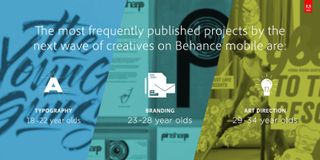3 trends set to impact the creative economy
Right now, a new generation of creatives is transforming the industry. Find out what they're up to...
Adobe has released its first set of findings from a new series of research on the creative economy.
As we reported in March, Adobe and Behance recently launched their first-ever book, Super-Modified, and this new research continues their exploration into the latest trends and techniques that are shaping the future of art and design.
Drawing real-time data from the public projects of nearly five million Behance users, the Adobe Digital Index research focuses on 'new creatives', placing a lens on some of the most formative years in a creative's career.
So how are the design interests and passions of this sector going to impact the next generation? Here are three trends that Adobe found…
01. Stretching the canvas: mobilising creativity

New technology and cutting-edge platforms are continually enabling creatives to stretch their 'canvas' and innovate on mobile devices. A study of 18-22-year-olds on Behance shows that the second screen has become more tightly integrated than ever into workflow, with on-the-go devices enabling creatives to create wherever their inspiration strikes.
Behance saw a 36 per cent increase in mobile logins last year. "With more and more creatives embracing mobile, we're thinking about how to remove the friction of the mobile process, increase the simplicity of design and making creative professionals more productive," says Sarah Rapp, head of community data and insights, Behance.
02. Creativity strikes in unexpected places

New hotbeds of creativity are emerging outside the traditional urban spots like Brooklyn, Hamburg, London and San Francisco. Adobe and Behance are seeing the most growth in Brazil, China, UK, India, Mexico, Russia and Canada.
Get the Creative Bloq Newsletter
Daily design news, reviews, how-tos and more, as picked by the editors.
"Other emerging and trending creative areas include Germany, France, Indonesia and Egypt," adds Rapp.
03. A return to raw elements and traditional techniques

New creatives on Behance are increasingly balancing the digital aspect of their projects with inspiration from the physical and tactile elements of design.
Demonstrating a rise in drawing and typography, this new generation of creatives are also using pen and ink more frequently than older age groups – although when Adobe examined the top three most appreciated projects for each age, handmade letting projects appeared in each sector.
"We're still seeing young artists on the cutting edge of all new technologies and ways to create, but we're also seeing this other interesting side of a return to more traditional tools and techniques," says Rapp. "In line with their tendency to create on-the-go, this group is perhaps being inspired by real-world elements and experiencing a return to the analog."
Next page: what do these trends mean for you?

Thank you for reading 5 articles this month* Join now for unlimited access
Enjoy your first month for just £1 / $1 / €1
*Read 5 free articles per month without a subscription

Join now for unlimited access
Try first month for just £1 / $1 / €1
The Creative Bloq team is made up of a group of design fans, and has changed and evolved since Creative Bloq began back in 2012. The current website team consists of eight full-time members of staff: Editor Georgia Coggan, Deputy Editor Rosie Hilder, Ecommerce Editor Beren Neale, Senior News Editor Daniel Piper, Editor, Digital Art and 3D Ian Dean, Tech Reviews Editor Erlingur Einarsson and Ecommerce Writer Beth Nicholls and Staff Writer Natalie Fear, as well as a roster of freelancers from around the world. The 3D World and ImagineFX magazine teams also pitch in, ensuring that content from 3D World and ImagineFX is represented on Creative Bloq.
